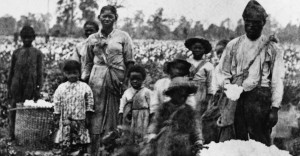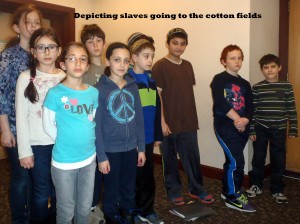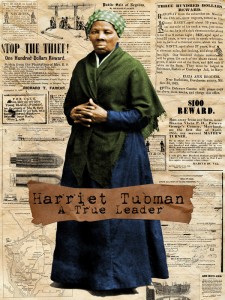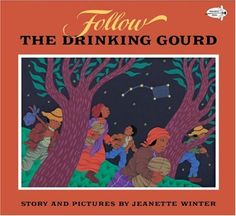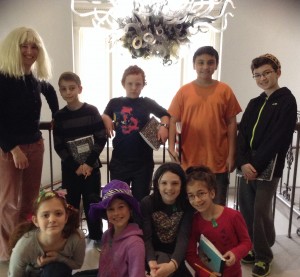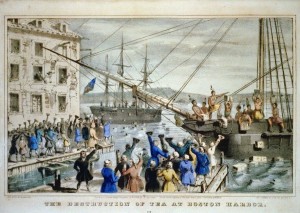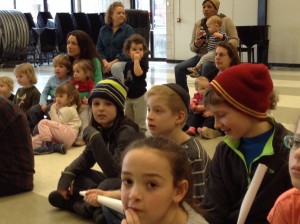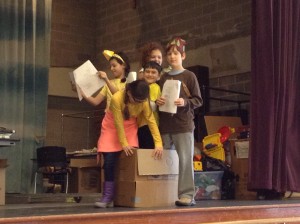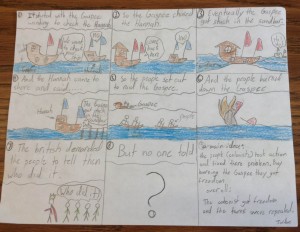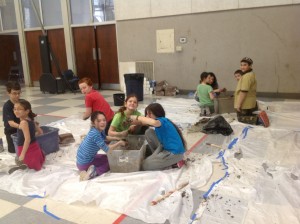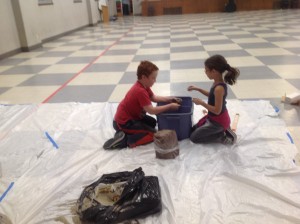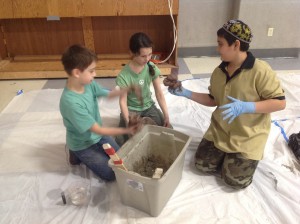What did we do on Tu B’Shvat?
The students in the Falafelim group learned how to use verbs in the past tense in Hebrew. Each one of the students wrote about what they did in Tu B’Shvat using some of these verbs – love, know, eat, sing, walk, hear, forget, drink, say, read, travel (by car.)
These are the common things they wrote about: We walked to the JCC, we performed at the JCC and at school, we sang a song, we heard songs, we ate oranges and raisins, we know about Tu BeShvat, we walked in the snow and we had fun.
Hope you enjoy reading and learning about their experiences using this link –
https://docs.google.com/document/d/1V8ZdotqzkZIChn_2VFVWwoMO2gO5aPbR9aabGuaPirQ/edit?usp=sharing
Rotem
לאמא ואבא,
בטו בשבט עשיתי הרבה דברים. קמתי, אכלתי ארוחת בוקר,והלכתי לבית ספר. בבית ספר הלכנו ל… ועשינו את ההצגה שישה בשקיק אחד. אני היתי התמר. גם עשינו את ההצגה לכל הילדים בבית ספר, אבל בפעם הזה לא היתי כלום. לא שכחתי את המילים שלי. הילדים בכיתה ב שרו שיר. אחרי בית ספר הלכתי לבית של תומר, ואחרי זה הלכתי להיתעמלות. הטו בשבט שלי היה מאוד כיף.
-תמר
בטו בשבט אנחנו הלכנו ל. אין-שם שרו סמבה בטו בשבט. ואני והפלאפלים עשינו הצגה. ואני בננה בהצגה. וגם עשיתי ב…ואני שר שיר סמבה בטו בשבט. ואני אכלתי תפוז וסימוכים ואני שתיתי מיץ תפוז.
בנימין
בטו בשבט אני הלכתי לבית ספר נתן בישוף. אני אוהבת נתן בישוף.
אליאורה
בטו בשבט הלכתי ל… עם כיתה ד וה. ב… עשינו הצגה לילדים ולאנשים זקנים. השם של ההצגה שישה בשקיק אחד. אנחנו גם עשינו את ההצגה באסיפה בבית ספר. אין-שם שרו סמבה לטו בשבט. לב כתב דף על מה עושים בטו בשבט ואמר את זה לפני ההצגה.אחרי שלב אמר מה עושים בטו בשבט אני יודעת מה עושים בטו בשבט.
בטו בשבט עשיתי הרבה דברים.
-סיון
בּטו בּשבט הלכנו ל… ואנחנו עשינו הצּגה. ההצגה על הספר שישה בּשקיק אחד. אני מספּר בהצגה וקראתי הרבּה מילים. אנחנו שמענו את אנשם שּרו סמבּה לטו בּשבט. אנחנו עשינו ההצגה בּבית ספר וההצגה טוב. יש לנו הרבּה כיף בּטו בּשבט.
-פּסח
לאבא ואמא,
אתמול בטו בשבט, אכלתי תפוז ב…. שמעתי את אין-שם שרו “סמבה לטו בשבט” אני גם הובלתי אסיפה בבית ספר עם יונה. הפלפלים גם עושים הצגה “ששה בשקיק אחד”
-לב
אתמול בטו-בשבט, יש ילדה. השם של הילדה זיוה. בבוקר זיוה נסעה לבית-ספר. כשזיוה בבית-ספר, זיוה הלכה ל … ב11:00. היא והחברים שלה בהצגה. עוד החברים של זיוה שרו את השיר סמבה לטו-בשבט. יש הרבה מאוד שלג . זה כיף מעוד.
זיוה
בטו-בשבט כל הילדים בכיתה ד וְה צריכים ללכת ל… כל הילדים שמחים מאוד. אתמול רותם אמרה ” אתם עושים הצגה”. כולם הולכים ל… ב11:00. אני אהבתי ללכת ל… כי יש הרבה מאוד שלג. כולם אהבו הצגה שהפלפלים עושים ואני אהבתי לשמוע את השיר אין-שם שרו .
אליענה
בטו בשבט הלכתי ברגל ל…. ב… שרתי שיר פעם אחד ושמעתי אותו שני פעמים. השם שלו היה סמבה. גם ב… עשיתי הצגה. השם שלו היה שישה בשקיק אחד. גם הובלתי אסיפה גדולה. וזה הוא.
יונה מ.
אתמול בטו בשבט משפחת אלון הלכו ליער ומצאו תפוחים. הם שמו את התפוחים בדבש. אחרי שהם אכלו הם הלכו לנחל ומצאו דגים. אבא לקח אבני צור ואת הסכין והדליק אש. בזמן שזה קרה אמא, ישי, נועה ומושי לקחו מקלות וחידדו אותם עם סכינים. הם הלכו למים וזרקו את המקלות על דגים ושמו אותם באש ואכלו אותם. כשהדג התבשל באש הם שרו את השיר סמבה לטו’ בשבט.

